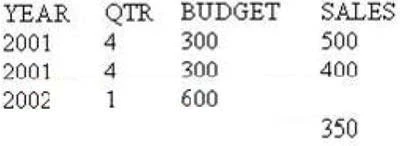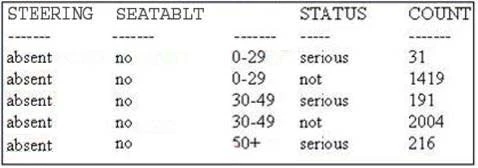Question 6 of 184
The following SAS program is submitted:
%micro test(var);
%let jobs=BLACKSMITH WORDSMITH SWORDSMITH;
%let type=%index(&jobs, &var);
%put type = &type;
%mend;
%test(SMITH)
What is the value of the macro variable TYPE when the %PUT statement executes?
%micro test(var);
%let jobs=BLACKSMITH WORDSMITH SWORDSMITH;
%let type=%index(&jobs, &var);
%put type = &type;
%mend;
%test(SMITH)
What is the value of the macro variable TYPE when the %PUT statement executes?
Correct Answer: C
Question 7 of 184
The following SAS program is submitted:
%macro check(num=4);
%let result=%eval(&nm gt 5);
%put result is &result;
%mend;
%check (num=10)
What is written to the SAS log?
%macro check(num=4);
%let result=%eval(&nm gt 5);
%put result is &result;
%mend;
%check (num=10)
What is written to the SAS log?
Correct Answer: C
Question 8 of 184
The following SAS program is submitted:
data temp;
length 1 b 3 x;
infile 'file reference';
input a b x;
run;
What is the result?
data temp;
length 1 b 3 x;
infile 'file reference';
input a b x;
run;
What is the result?
Correct Answer: C
Question 9 of 184
Given the SAS data sets ONE and TWO:

The following SAS program is submitted:
Proc sql;
Select two.*,budget from one <insert JOIN operator here> two on one.year=two.year,
Quit;
The following output is desired:

Which JOIN operator completes the program and generates the desired output?

The following SAS program is submitted:
Proc sql;
Select two.*,budget from one <insert JOIN operator here> two on one.year=two.year,
Quit;
The following output is desired:

Which JOIN operator completes the program and generates the desired output?
Correct Answer: A
Question 10 of 184
Given the SAS data set SAUSER.HIGWAY:
SASUSER.HIGHWAY -

The following SAS program is submitted:
%macro highway;
proc sql nonprint;
%let numgrp=6;
select distinct status into:group1-:group&numgrp from sasuser.highway; quit;
%do i=1 %to &numgrp;
proc print data =sasuser.highway;
where status ="&&group&I";
run;
%end;
%mend;
%highway
How many reports are produced?
SASUSER.HIGHWAY -

The following SAS program is submitted:
%macro highway;
proc sql nonprint;
%let numgrp=6;
select distinct status into:group1-:group&numgrp from sasuser.highway; quit;
%do i=1 %to &numgrp;
proc print data =sasuser.highway;
where status ="&&group&I";
run;
%end;
%mend;
%highway
How many reports are produced?
Correct Answer: A